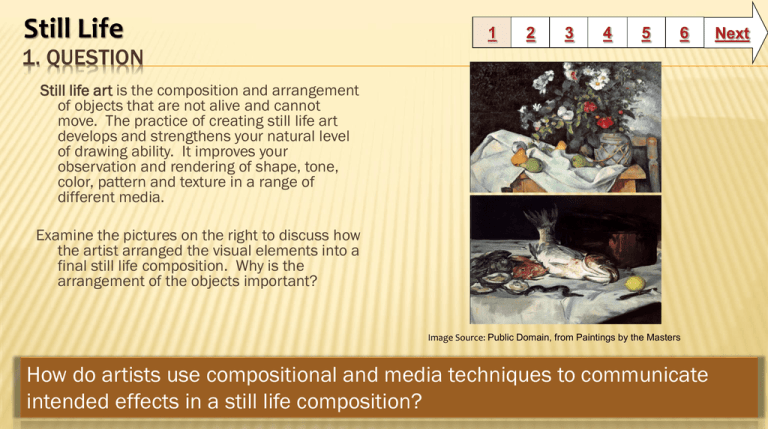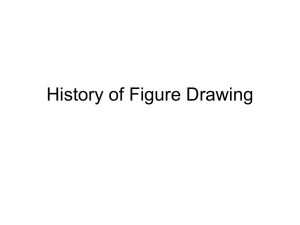
1
2
3
4
5
6
1. QUESTION
Still life art is the composition and arrangement
of objects that are not alive and cannot
move. The practice of creating still life art
develops and strengthens your natural level
of drawing ability. It improves your
observation and rendering of shape, tone,
color, pattern and texture in a range of
different media.
Examine the pictures on the right to discuss how
the artist arranged the visual elements into a
final still life composition. Why is the
arrangement of the objects important?
Image Source: Public Domain, from Paintings by the Masters
How do artists use compositional and media techniques to communicate
intended effects in a still life composition?
Next
2. INFORMATION SOURCES
1
2
3
4
5
6
Next
You will use these resources to critique and compare two
artists’ still life compositions and media techniques:
View these sites and videos to learn more about the still life
artists highlighted in the text, A Global Pursuit
Still-life- Amelia Pelaez (Cuba), View this de Haam video
Still-life of Fruit and Flowers - Paul Cézanne (France), View
the Cézanne video
Still-life with Parrots- Jan Davidsz de Haam (Netherlands),
View this de Haam video
Parrots Live Forever- Audrey Flack (United States), View
this Audrey Flack Video
View these sites and videos to learn more about the still life
artists highlighted in the text, A Personal Journey
Dishes- 1964, James Rosenquist (United States),
Still-life of Fruit and Flowers-after 1620, Clara Peeters
(Flanders), View this Peeters still life video
.
Image Source: WikiPaintings, Cape Cod still life
Image Source: Rosenquist, James. Dishes, 1964. Oil on Canvas, VAGA,
New York. A Personal Journey: Explorations in Art. By Marilyn G.
Stewart. Massachusetts: Davis Publications, 2009. 55. Print.
3. STUDENT ACTIVITY
1
2
3
4
5
6
Next
Use the sites on Slide 2 to compare two different still life
artworks. You may use the attached inquiry organizer or
your journal to record ideas and information. Make sure
to cite the artists, works, titles, and years as your reflect
and compare. Use the following questions as a guide:
•
How does the artist balance the painting?
•
Is the composition symmetrical or asymmetrical? How do
you know?
•
Can you see examples of repetition, movement and
contrast?
•
What medium is used for the final still life artwork?
•
What moods and ideas do you think the painting
conveys? Explain your answer using specific examples
from the artwork.
You will use what you have learned about still life
composition and media techniques to create your own
sketch and charcoal drawing.
Symmetrical Composition
Image Source: Raphaelle Peale, A Dessert (Still Life with Lemons and
Oranges), 1814, oil on panel, National Gallery of Art, Washington,
Gift (Partial and Promised) of Jo Ann and Julian Ganz Jr. in memory
of Franklin D. Murphy 1999.44.1, Net Trekker Subscription
4. ASSESSMENT ACTIVITY
1
2
3
4
5
6
Next
Reflect on the artists and artwork you explored in the Student
Activity. Think about what objects you would like to use for the
subject of your own still life work. What are your interests? What
objects do you use on a daily basis? What objects reflect an issue
or topic that’s important to you?
Working from observation, use the attached guidelines to take you
through the process of completing a still life sketch and final
charcoal drawing that utilizes accurate placement, proportion of
items, and values to depict form. The finished charcoal drawing
should appear realistic including the use of shading, cast
shadows, and highlights.
As you plan your charcoal drawing and prepare to sketch, think
about:
•
How to break down a still life drawing into shapes.
•
How a sketch will have to achieve a level of proportion and
composition in order to prepare you to create a charcoal drawing.
•
Why artists generate several drawings or studies of the same or
similar objects.
Image Source: Peeters, Clara. Still Life of Fruit and
Flowers, after 1620. Oil on Copper, Asholean Museum,
Oxford. A Personal Journey: Explorations in Art. By
Marilyn G. Stewart. Massachusetts: Davis
Publications, 2009. 156. Print.
5. ENRICHMENT ACTIVITIES
1
2
3
4
5
6
Explore Still Life
•
•
•
•
•
•
Image Source: Flack, Audrey. Parrots Live Forever, 1978. Oil over acrylic on canvas,
Louis K. Meisel Gallery, New York. A Global Pursuit: Explorations in Art. By Marilyn
G. Stewart. Massachusetts: Davis Publications, 2009. 133. Print.
Take a Still Life Tour from the National
Gallery of Art
View the site that scoops about what is
going on in the world of Still Life today
View this Still Life Glogster to explore an
example of how to organize your art and
reflections
Visit the The Metropolitan Museum of Art
still life site and explore the collection by
artist and era
Browse the still life artists featured at the
MoMA
Visit NGA Kids Still Life to create your
own still life composition
Next
6. TEACHER SUPPORT MATERIALS
National Art Standards
Content Standard #1: Understanding media, techniques and processes.
Achievement Standard:
•
Students know the differences between materials, techniques, and processes
•
Students describe how different materials, techniques, and processes cause different responses
•
Students use different media, techniques, and processes to communicate ideas, experiences, and stories
•
Students use art materials and tools in a safe and responsible manner
International Society for Technology in Education (ISTE)
3. Research and Information Fluency
Students apply digital tools to gather, evaluate, and use information.
a. Plan strategies to guide inquiry
b. Locate, organize, analyze, evaluate, synthesize, and ethically use information from a variety of sources and
media
c. Evaluate and select information sources and digital tools based on the appropriateness to specific tasks
d. Process data and report results
Common Core State Standards
Reading: 1. Read closely to determine what the text says explicitly and to make logical inferences from it; cite
specific textual evidence when writing or speaking to support conclusions drawn from the text.
Writing: 7. Conduct short as well as more sustained research projects based on focused questions, demonstrating
understanding of the subject under investigation.
Standards for the 21st Century Learner
1.1.6 Read, view, and listen for information presented in any format (e.g. textual, visual, media, digital) in order to
make inferences and gather meaning.
2.1.3 Use strategies to draw conclusions from information and apply knowledge to curricular areas, real-world
situations, and further investigations.
Maryland Technology Literacy Standards for Students
3.0: Use a variety of technologies for learning and collaboration.
1
2
3
4
5
6
Time Frame: 60 – 90 minutes
Enduring Understanding
An artist's culture and surroundings can influence their work
and process.
Artists create images inspired by their surroundings to
communicate ideas and information about time, places,
and themselves.
Differentiation:
•
Direct students to use comprehension tools included in
databases, such as: audio read-aloud, labeled reading
levels, and embedded dictionaries.
Learning Styles: Visual , Reflective, Kinesthetic, Tactile
Notes to the teacher:
You may utilize the provided organizers and rubrics or create
you own. Please check all links before you view the videos
with students. The You Tube videos will need to be shown by
the teacher.
Last updated: July 2012
Created by Anna Conner and Marilyn McDonald
BCPS Slam Dunk Research Model, Copyright 2012, Baltimore County Public Schools, MD, all rights reserved. The models may be used for educational, non-profit school use only.
All other uses, transmissions, and duplications are prohibited unless permission is granted expressly. This lesson is based on Jamie McKenzie’s Slam Dunk Lesson module








